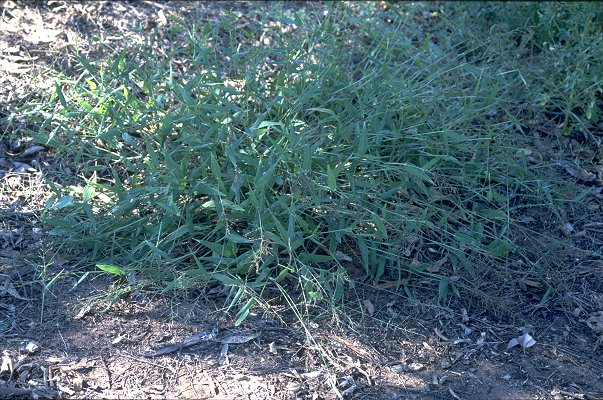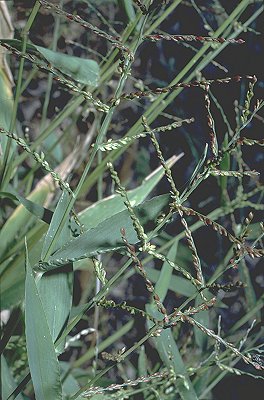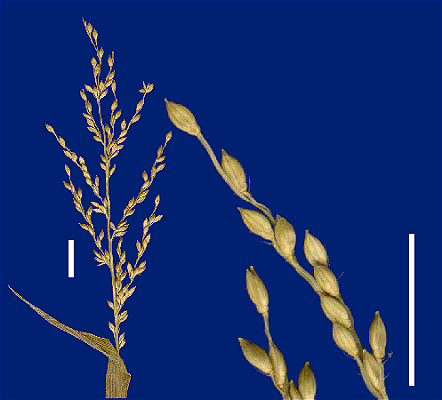Urochloa praetervisa (Domin)
D.K.Hughes. Bull. Misc. Inform. 446 (1934).
Classification. (GPWG 2001) : Subfamily Panicoideae. Paniceae.
Basionym and/or
Replacement Name: Panicum
praetervisum Domin, Biblioth. Bot. 85: 309 (1915).
Type of Basionym or
Protologue Information: HT: Andrews 156, Australia:
South Australia:
vicinity of Lake Eyre (?).
Recent synonyms:
B. windersii, Brachiaria praetervisa.
Key references
(books and floras): [1981] M.Lazarides in J.Jessop (ed)., Flora of
Central Australia (476 & as Brachiaria windersii), [2002]
D.Sharp & B.K.Simon, AusGrass, Grasses of Australia (as Brachiaria),
[2006] J.Jessop, G.R.M.Dashorst, F.M.James, Grasses of South Australia
(429 as Brachiaria), [2008] S.W.L.Jacobs, R.D.B.Walley &
D.J.B.Wheeler, Grasses of New South Wales (396).
Illustrations:
[2006] J.Jessop, G.R.M.Dashorst, F.M.James, Grasses of South Australia (430, fig. 360 as Brachiaria), [2008]
S.W.L.Jacobs, R.D.B.Whalley & D.J.B.Wheeler, Grasses of New South Wales,
4th edn (396).
Habit. Annual.
Rhizomes absent. Stolons absent or present. Culms erect or geniculately
ascending, stature slender to delicate, 20–60 cm tall, 2–3 -noded. Mid-culm
internodes glabrous or pubescent. Mid-culm nodes pubescent. Leaf-sheaths
glabrous on surface or hairy. Ligule a fringe of hairs. Leaf-blades lanceolate,
40–170 cm long, 4–13 mm wide. Leaf-blade surface glabrous or indumented.
Inflorescence.
Inflorescence compound, a panicle of racemes. Racemes 3–8, 2–7 cm long, 2–4 mm
wide. Central inflorescence axis 5–12 cm long.
Spikelets.
Spikelets pedicelled. Fertile spikelets 2-flowered, the lower floret barren
(rarely male), the upper fertile, comprising 1 basal sterile florets,
comprising 1 fertile floret(s), without rachilla extension, elliptic or ovate,
dorsally compressed, 2.8–4 mm long. Rhachilla internodes brief up to lowest
fertile floret.
Glumes. Glumes
dissimilar, thinner than fertile lemma. Lower glume ovate, membranous, without
keels, 3–5 -nerved. Upper glume ovate, 2.7–3.9 mm long, membranous, without
keels, 7 -nerved. Upper glume surface glabrous. Upper glume apex muticous. Florets.
Basal sterile florets 1, barren, with palea. Lemma of lower sterile floret 100
% of length of spikelet, membranous, 5 -nerved.
Fertile lemma 2.3–3.5
mm long, without keel. Lemma apex mucronate or awned. Palea without keels.
Continental
Distribution: Australasia.
Australian Distribution:
Western Australia, Northern
Territory, South Australia, Queensland, New
South Wales.
Western Australia: Gardner, Dampier. Northern Territory: Barkly Tableland, Central
Australia North, Central Australia South. South Australia: North-western, Lake Eyre, Gairdner-Torrens Basin,
Flinders Ranges,
Eastern, Eyre Peninsula. Queensland: Cook, Burke, North
Kennedy, Gregory North, Gregory South, Warrego. New South Wales: North-Western
Plains, North Far Western Plains.
Notes.
Hubbard (1938) used inflorescence form and hairiness of the pedicels to
recognize B. windersii, however, the two forms obviously intergrade and
most specimens are intermediate. Setae can occur on the pedicels in this and
other species, making this attribute of limited taxonomic importance.
Diagnostic features of U. praetervisa include the glabrous paired
spikelets, spikelet length, the presence of a well developed palea on the lower
floret, and the distinct straight mucro of the upper floret.
In tropical and
subtropical sub-humid woodlands, semi-arid shrub woodlands, arid and semi-arid
low woodlands, shrub steppe shrublands, acacia shrublands, arid tussock
grasslands, arid hummock grasslands, and tropical sub-humid grasslands.
Frequently associated with disturbed habitats. Flowers mostly Dec.-June.





